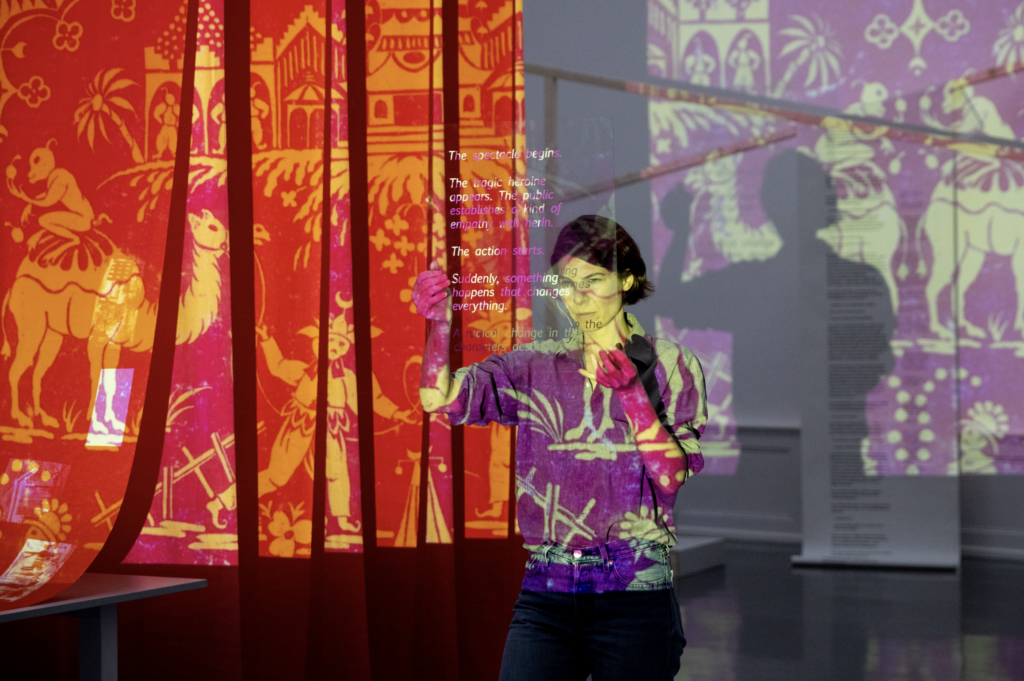ENGLISH
Romy Nína Rüegger has dedicated her research since 2013 to the history of laborers, textile production, and the colonial trade in motifs and fabrics. Through an expansive intervention in a former weaving mill at the Legler Areal titled A Fabric in . . . Red (2024), through a video and sound work, and a performance entitled Cliché no Protagonist [accountable] (2024), she questions historical narratives, juxtaposing documentary with subjective accounts. Her focus spans waterways and anticolonial and feminist narratives within Glarus’ textile history.
Central to her exploration is a lost print motif dating back to 1836, depicting Turkish red fabric with a Far Eastern pattern, sourced from the Wirtschaftsarchiv in Schwanden/Glarus. This motif serves as a catalyst for examining early industrial textile production, labor strikes by women and children, early labor rights, “silent colonialisms,” and Europe’s involvement in the slave trade and labor migration. She prints various archival materials onto a length of fabric and—guided through the building—makes it the carrier of her search for the specific shade of red that made the factory owners wealthy. In doing so, she investigates the injustices of Europe and its involvement in the slave trade.
In an immersive sonic experience, she acoustically transforms the exhibition space with 240 beats per minute, echoing the resonant impact of wooden mallet hammers used in early industrial printing presses. Her work for the Klöntal Triennale extends beyond Glarus to include ongoing research in Schwanden, Diesbach, Ancona, Indonesia, and Shanghai.
Romy Nína Rüegger (*1983, CH, lives in Zurich and Berlin) has presented her recent performances at venues such as the ARé Performing Arts Festival (Yerevan) in 2023, and had commissions and solo exhibitions at Cashmere Radio (Berlin) in 2023, at the Stedelijk Museum (Amsterdam) in 2022, and the Badischer Kunstverein (Karlsruhe) from 2020 to 2021.
Romy Nína Rüegger recherchiert seit 2013 zur Geschichte der Arbeiter*innen, zu Textilproduktion und kolonialem Motiv- und Stoffhandel. Mit einer raumgreifenden Intervention mit dem Titel «A Fabric in … Red» (2024) im Gebäude der ehemaligen Weberei, einer Video- und einer Soundarbeit sowie einer Performance mit dem Titel «Cliché no Protagonist [accountable]» (2024) befragt Romy Nína Rüegger historische Narrative und konfrontiert dokumentarische mit subjektiven Erzählweisen – entlang von Wasserwegen sowie anti-kolonialen und feministischen Narrativen in der Glarner Textilgeschichte.
Die Künstlerin nimmt ein verschollenes Druckmotiv von 1836 für ein türkischrotes Tuch mit einem fernöstlichen Muster aus dem Wirtschaftsarchiv in Schwanden/Glarus zum Ausgangspunkt ihrer Recherche zu frühindustrieller Textilproduktion, Arbeitsstreiks von Frauen und Kindern, frühen Arbeitsrechten, «stillen Kolonialismen» und Involviertheiten in den Sklavenhandel und in Arbeitsmigration. Sie bedruckt eine Stoffbahn mit verschiedenen Archivmaterialien und macht sie – durch das Gebäude geführt – zur Trägerin ihrer Suche nach demjenigen Rot, das die Fabrikanten reich machte und geht so den Ungerechtigkeiten Europas und seiner Involviertheit in den Sklavenhandel nach. Mit 240 Beats pro Minute wird der Ausstellungsraum zudem akustisch zum Resonanzkörper von Holzschlegel-Hämmern, die einst auf Druckmodel einschlugen und durch die Hallen der frühindustriellen Druckstuben donnerten.
Ihre Arbeit für die Klöntal Triennale ist eine Erweiterung einer fortlaufenden Recherche an Orten wie Glarus, Schwanden, Diesbach, Ancona, Indonesien oder Shanghai.

Romy Nína Rüegger (*1983, CH, lebt in Zürich und Berlin) kürzliche Auftritte und Einzelausstellungen fanden statt 2023 auf dem ARé Performing Arts Festival (Yerevan), 2023 Cashmere Radio (Berlin), 2022 im Stedelijk Museum (Amsterdam), sowie 2020–2021 im Badischen Kunstverein (Karlsruhe).
Foto: Romy Nína Rüegger, The Moving Body, The Listening Body – Moving through wires of wind, Ausstellungsansicht, Badischer Kunstverein, Karlsruhe 2020. © Stephan Baumann, bild_raum
